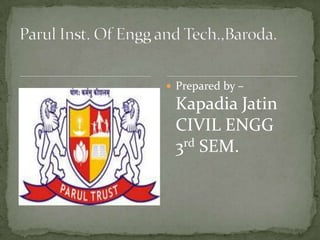
Batching and Mixing of Concrete Aggregates
- 1. Prepared by – Kapadia Jatin CIVIL ENGG 3rd SEM.
- 2. Batching of Aggregate___ I. Volume batching II. Weigh batching Volume batching • This method is generally adopted for small jobs . • Gauge boxes are used for measuring the fine and coarse aggregate. • The volume of gauge box is equal to the volume of one bag of cement.
- 3. Gauge bow are also called as FARMAS They can be made of timbers or steel. They are made generally deep and narrow Bottomless gauge boxes are generally avoided. While filling the gauge boxes the material should be filled loosely,no compaction is allowed.
- 4. Weigh Batching • Batching by weight is more preferable to volume batching ,as it is more accurate and leads to more uniform proportioning. • It does not have uncertainities associated with bulking. • It’s equipments falls into 3 general catagories: I. Manual, II. Semi automatic, III. Fully automatic.
- 5. 1) In case of manual batching all weighing and batching of concrete are done manually.It is used for small jobs. 2) In case of semi automatic batching the aggregate bin gates are opened by manually operated switches.And gates are closed automatically when the material has been delivered. This system also contains interlock which prevents charging and discharging. 3) -----
- 6. 3) In case of automatic batching the material are electrically activates by a single switch and complete autographic record are made of the weight of each material. The batching plant comprises 2,3,4 or 6 compartment bins of several capacities.Over the conveyer belt the weigh batchers discharging are provided below the bins.
- 7. Mixing of Aggregate • The Aim of mixing of concrete is to produce homogenous,consistent and uniform coloured concrete. Mixing action of CONCRETE involves 2 operation i. A general blending of different particles size of the ingredients to be uniformly distributed throughout the concrete mass. ii. A vigorous rubbing action of cement paste on to the surface of aggregate particles.
- 8. There are 2 methods 1. Hand mixing, 2. Machine mixing. Hand mixing • For small and unimported jobs concrete is mixed by Hand using showels.As mixing of concrete is not eficient throughtly ,it is advisable to add 10 persent CEMENT. • For hand mixing a brick platform is prepared by laying the bricks on the ground.It must be 2 m wide and 3.5 m long. Following operations are involved
- 9. 1. Measured quantity of sand is spread evenly on platform. 2. Spread the measured quantity of cement on this sand and mix it till the colour of concrete mixture is uniform. 3. Spread the measured quantity of coarse aggregate on the platform with sand and cement.Now spread the mixture of cement and sand on the stack of aggregate and mix it atleast 3 times. 4. Make the hollow of mixed pile.Add 3 quarters of total quantity of water required and turn thematerial towards the centre with spades.
- 10. Machine mixing • It is adopted for big projects where large quantity of aggregate is required .It is also Economical. • Concrete mixers are classified as unders- According to the operating conditions- 1. Batch mixers , 2. Continuous mixers. According to the principal of mixing- 1. Gravity type 2. Type with forced mixing
- 11. According to the condition of use 1. Stationary concrete mixers, 2. Portable concrete mixers. Batch mixers • The mixers are charged with materials in batches • Batch mixers are classified in further 3 types 1. Tilting type , 2. Non-Tilting type , 3. Reversing type.
- 12. As per IS :1971-1985, concrete mixers are designated by a number representing its nominal mixed batch capacity in litres. I. Tilting type-85 T, 100 T,140 T,200 T. II. Non-Tilting type-200 NT,280 NT,375 NT,500 NT,1000 NT. III. Reversing type-200 R,280 R,375 R,500 R,1000 R. T-tilting type NT-non tilting type R-reversing type.
- 13. Non tilting type mixer • The mixing drum is cylindrical in shape and revolves two – horizontal axis. • It has opening on both sides. • The ingredients are charged in from one opening. • For discharging concrete chute is introducedin to other opening by operating a lever.
- 14. Tilting type mixer It consist a conical drum which rotates on an inclinable axis. It has only one opening. The drum charged directly and discharged by tilting and reversing the drum.
- 15. About the half of the quantity of coarse aggregate is placed in the skip over the which about half of the sand is poured,on that fully quantity of cement. i.e.,-1 bag is poured over which the remaining quantity of coarse aggregate and sand is placed. Before charging the drum abot 25% of water is required for mixing. After discharging the loaded skip into the remaining 75% is poured water. If plastisizer is used 1 litre of water is hold back.
- 16. Thank You.
